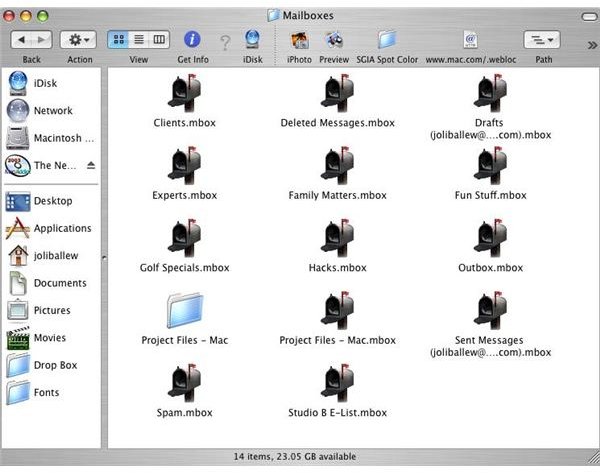Advice on Receiving and Saving Email Attachments - Be Aware of the Risks of Email Attachments and Learn How to Use Archiving
Introduction
You probably get a lot of attachments, and you probably keep many of them. In this article I’ll start by offering some tips for dealing with attachments, and then show you how to archive e-mail you want to keep.
Tips for Working with Attachments
· Do not use Mail as a storehouse for attached files. When a message appears with an attachment, immediately save the attachment to a separate location on the hard drive if is to be retained. If not, delete it.
· Don’t open an attachment unless you know what it is. If you don’t know who it came from, don’t open it! This is how viruses propagate.
· Don’t open attachments from Apple; Apple won’t be sending you anything like that. The same is true of your ISP. If in doubt, visit the company’s Web page for verification.
· Keep an eye out for attachments in your Sent folder. If you’ve forwarded a message that contains a large attachment, that message and attachment will remain in your Sent folder until you delete it.
· If you can’t open an attachment, drag it to the StuffIt Expander icon in the Applications>StuffIt folder. This utility almost always opens any attachment. You might also drag this utility to the Dock if you use it often.
· Use Mail’s Message>Remove Attachments to send unwanted attachments to the Trash. Periodically review your Sent folder and delete any messages with attachments. If you are pressed for time, look for the messages that have the biggest attachments.
My mantra is delete, delete, delete. Delete e-mail with unwanted attachments from your Sent folder, delete unwanted attachments from folders you’ve created, and finally, delete what’s in the Trash.
Tip: You can sort your messages by file size. Just Control+click the bar that contains the From, Subject, Date, and Received headings and check Size. Click the new heading to sort your e-mail by file size.
Archive Messages
For many people, deleting old e-mail that may contain an ounce of something that may be needed later is unthinkable. If you’re one of those people, that’s okay, as long as you know how to save that data and store it somewhere else so that it doesn’t become clutter. In addition, everyone at some point in time will want to create a backup of their mail. That’s certainly important if you use e-mail daily and your job depends on it, as mine does.
Before we get into the nitty-gritty of archiving, though, let’s first take a look at how mail is actually stored on your Mac. Open Finder>your home folder>Library>Mail>Mailboxes and take a look at what’s in there. [See Image 1]
Double-clicking any mailbox that currently exists in your Mail setup opens Mail and the folder that corresponds to the mailbox. Because there’s an icon for each mailbox folder here, you can easily drag and drop to another drive to copy the information and archive it. Here’s an even quicker way to archive a particular mailbox folder:
1. Open Finder>your home folder>Library>Mail>Mailboxes.
2. Decide what mailbox folder to archive and Control+click it.
3. From the resulting drop-down list, select Create Archive Of “folder name.”
4. Drag the new ZIP file to the area of your hard disk (or external hard disk) where you keep archived files.
5. If you ever need to use those files again, unzip them. Then, drag the file back to the Mailboxes folder. (If necessary, rename the mailbox before dragging.)
How often you should archive your e-mail depends on how much e-mail you get, how important it is to you, and how much you save (just in case you ever need it). Consider archiving weekly if your business (or your livelihood) depends on your e-mail.
